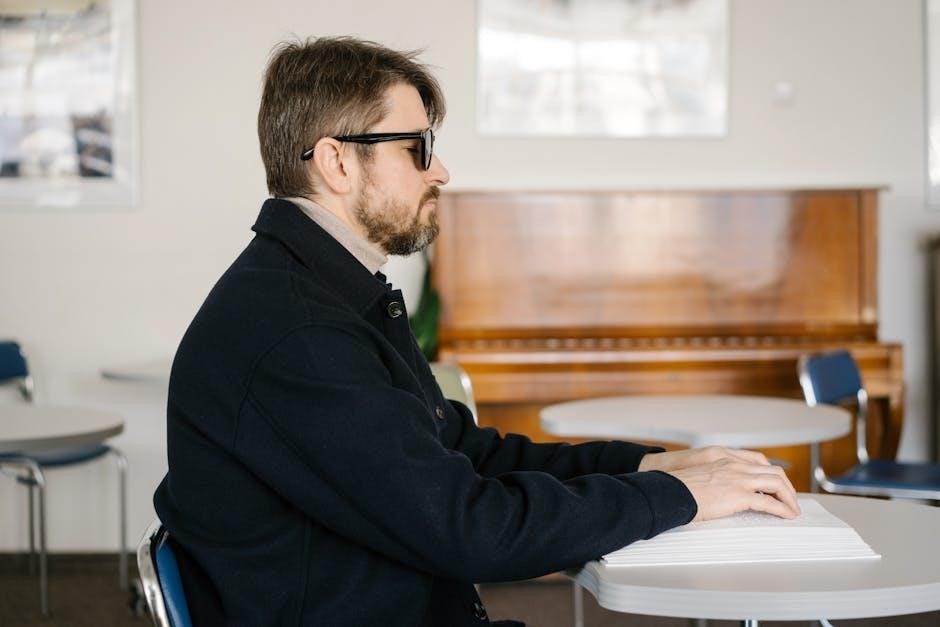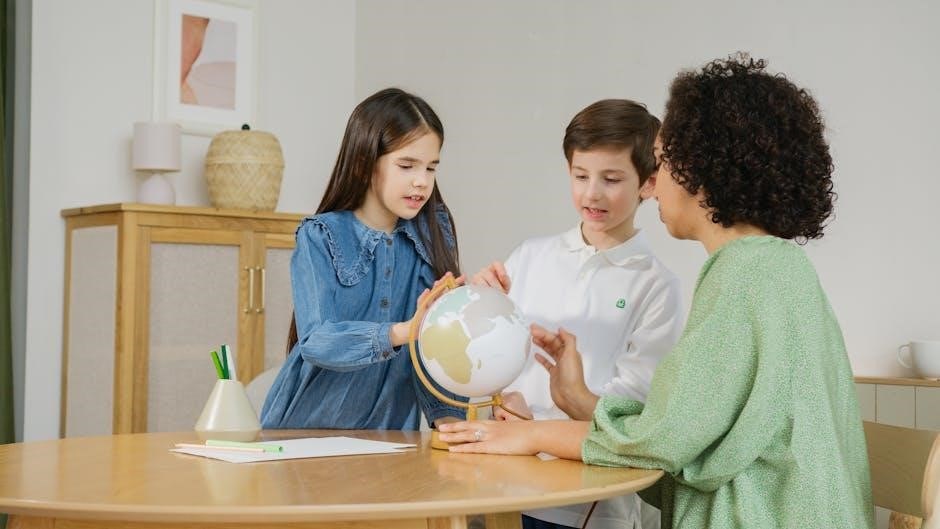This guide empowers general education teachers navigating the complexities of special education. It offers concrete suggestions, procedures, and clarity on legal aspects, fostering inclusive classroom integration for diverse learners with disabilities.
The Importance of Understanding Special Education
Understanding special education is vital for all teachers, as they are increasingly tasked with educating students with diverse learning needs. This knowledge ensures educators can navigate special education laws, effectively participate in IEP development, and implement best practices in inclusive classrooms. Training in special education strategies, understanding legal rights, and staying updated on the latest research greatly enhance a teacher’s ability to provide inclusive teaching. Ultimately, supporting students with Special Educational Needs (SEN) is a crucial aspect of inclusive education, promoting equitable learning environments for all students, regardless of their abilities or challenges.

Legal Framework and Special Education
Navigating the legal landscape of special education is crucial for educators. Understanding key laws ensures compliance and protects the rights of students with disabilities, fostering equitable access to quality education.
Key Laws Affecting Special Education (IDEA)
The Individuals with Disabilities Education Act (IDEA) is paramount. This law mandates responsibilities for educators in planning, implementing, and diligently monitoring educational plans tailored for students with special needs. IDEA ensures these students receive a free and appropriate public education (FAPE) in the least restrictive environment (LRE). It emphasizes parental involvement in the IEP process, safeguarding their rights and promoting collaboration between home and school. Understanding IDEA is vital for providing equitable opportunities and fostering the success of students with disabilities, empowering educators to create inclusive and supportive learning environments that cater to diverse needs.

The Referral and Evaluation Process
When a student needs special education, the referral process begins. This chapter details the steps, eligibility, and the general education teacher’s role. Guidance is offered for what teachers can learn.
Steps in the Referral Process
The referral process starts when a student exhibits academic or behavioral difficulties. Initial concerns are documented, followed by pre-referral interventions within the general education setting. If these interventions prove insufficient, a formal referral for special education evaluation is initiated. Parents are informed and their consent obtained for assessment. A multidisciplinary team, including teachers and specialists, conducts comprehensive evaluations. The team reviews data, determines eligibility based on specific criteria, and if eligible, develops an Individualized Education Program (IEP) tailored to the student’s unique needs. Throughout, collaboration and communication between all parties are crucial.
Individualized Education Programs (IEPs)
IEPs are vital plans for students with disabilities. They outline specific learning goals, accommodations, and services. Developed collaboratively, they ensure students receive appropriate support to succeed academically and developmentally.
The General Education Teacher’s Role in IEP Development
General education teachers play a crucial role in IEP development, offering valuable insights into a student’s classroom performance, strengths, and areas needing support. Their perspective ensures the IEP is practical and aligned with the general curriculum. They collaborate with special education staff, parents, and other professionals to create a comprehensive plan. They contribute knowledge of effective teaching strategies, accommodations, and modifications to foster student success. Active participation ensures the IEP addresses the student’s needs within the inclusive classroom environment, promoting progress and engagement. Their involvement is essential for effective implementation.

Inclusive Classroom Strategies
Creating an inclusive classroom involves adapting instruction to meet diverse learning needs. Employing varied teaching methods, providing differentiated materials, and fostering a supportive environment ensures all students can access the curriculum and thrive.
Adapting Instruction for Diverse Learners
Adapting instruction is crucial for meeting the varied needs within an inclusive classroom. This involves modifying teaching methods and materials to ensure all students can access and understand the curriculum. Consider offering differentiated assignments, providing visual aids, and using assistive technology. Flexible grouping strategies, like small group instruction or peer tutoring, can also be beneficial. Furthermore, it’s important to provide extra support for learners with special educational needs, by adjusting the pace of instruction. Regularly assess student progress and adjust strategies as needed to maximize each student’s learning potential within the classroom.
Assessment and Progress Monitoring
Assessment and progress monitoring are critical for tracking student growth in special education. Effective strategies and tools help teachers monitor progress, adjust instruction, and ensure IEP goals are met effectively.
Effective Assessment Tools and Strategies
Selecting appropriate assessment tools is crucial for accurately gauging student progress. These tools should align with IEP goals and provide data for informed instructional decisions. Observations, portfolios, and standardized assessments offer diverse insights into student learning. Regular progress monitoring ensures timely adjustments to teaching strategies. AI-powered tools can help special education teachers assess how well students are meeting their IEP goals. These help identify areas needing improvement, and adjust instructional strategies, this ensures effective and personalized support for students with special needs, enhancing their educational outcomes.
Classroom Management and Student Behavior
Effective classroom management is crucial in special education. Addressing student behavior requires understanding individual needs. Positive reinforcement and proactive strategies foster a supportive learning environment. Collaboration with specialists ensures consistent and effective behavioral support for all students.
Strategies for Managing Behavior in Special Education
Managing behavior in special education requires proactive and individualized strategies. Implementing positive behavior support (PBS) systems can foster a positive classroom environment, focusing on prevention and reinforcement. Understanding the function of a student’s behavior is key to developing effective interventions. Employing visual supports, social stories, and structured routines can aid in predictability and reduce anxiety. Consistency in applying behavior management techniques across settings is essential. Collaboration with special education staff and parents ensures a unified approach, promoting student success and well-being. Data collection helps to monitor progress and adjust strategies accordingly, fostering a supportive learning environment.

Collaboration with Special Education Staff
Effective collaboration is crucial for supporting students with special needs. General education teachers must actively work with special education teachers and related service providers to implement IEPs and create inclusive learning environments.
Working with Special Education Teachers and Related Service Providers
General education teachers play a vital role in supporting students with disabilities. Collaboration with special education teachers and related service providers, such as therapists and counselors, is essential for effective instruction. Sharing insights, data, and observations ensures a comprehensive understanding of each student’s needs.
Regular communication and co-planning sessions facilitate the implementation of Individualized Education Programs (IEPs). This collaborative approach allows for tailored instruction, accommodations, and modifications that promote student success. Open dialogue fosters a supportive and inclusive learning environment for all;
Transition Planning
Transition planning prepares students with disabilities for post-secondary life. It involves setting goals, developing skills, and accessing resources for future success in education, employment, and independent living, ensuring a smooth transition.
Preparing Students for Post-Secondary Life
Preparing students with disabilities for post-secondary life involves a multifaceted approach that encompasses academic, vocational, and social-emotional development. It is crucial to begin this process early, ideally during the middle school years, to allow ample time for exploration and skill-building. Transition planning should be student-centered, focusing on individual strengths, interests, and needs.
This includes providing opportunities for career exploration, work-based learning experiences, and self-advocacy training. Collaboration between educators, families, and community agencies is essential to ensure a seamless transition to post-secondary education, employment, or independent living. The ultimate goal is to empower students to achieve their full potential and lead fulfilling lives after graduation.
Resources and Support for Teachers
Teachers can greatly enhance their ability to provide inclusive teaching through training in special education strategies. Staying updated on the latest research and understanding legal rights are also vital for educators.
Professional Development and Training Opportunities
To effectively support students with special needs, ongoing professional development is crucial for teachers. Numerous training opportunities exist, focusing on special education strategies, legal rights, and the latest research. Educators can enhance their skills through workshops, conferences, and online courses. Some programs cover specific disabilities, assessment tools, or inclusive classroom management techniques. Many resources are available through disability and education groups, offering support and teaching materials. Seek out opportunities to collaborate with special education experts to refine your skills and stay up-to-date.
